


Wouldn't You Really Rather Drive a 20 Gauge?
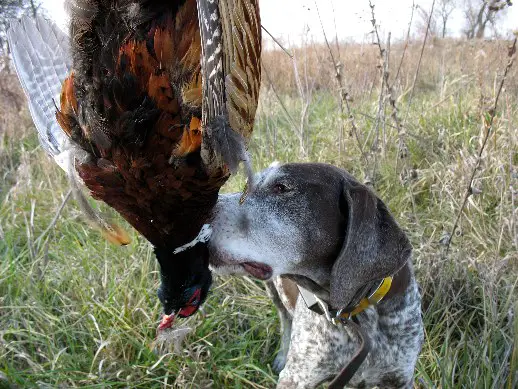
Gone
but never forgotten, Rocky was a dedicated and talented hunting companion.
This was the last pheasant Rocky ever found. It was dropped at 45 yards
with a Browning B-80 twenty gauge and a Federal #PFC258 shell.
If you believe what many, if perhaps most, hunters and shooters are saying, the answer would be a resounding, “Yes!” Not all of us say exactly what we mean all of the time, of course, but if you hear what I hear most often then the twenty gauge would easily be the world's most popular shotgun gauge today, not the twelve.
The basis for this goes back to the storied British Game Gun, the joyful to carry, quick to shoulder, lighting fast, responsive type of gun that is often talked about and yearned for. Certainly, “joy to carry” and “joy to shoot” don't always come in the same box, but you'll hear the “joy to carry” phrase often enough-- sometimes when nothing else can be said about the overall quality of the gun.
While many 12 gauges struggle and strain to get below the 7 pound mark, any number of 20 gauges are already there without the prominent use of plastic, techno-polymers, or fake wood. Any number of the twenty gauges that I use most often (B-80, A303, A-5 20 Mag) and several recently reviewed twenty gauges (Browning Silver and Browning Cynergy) all get under 6-1/2 pounds quite easily and they are far from alone. Yet, they do it without plastic stocks, ribs, fake wood, and both the Cynergy and A-5 manage it with steel receivers as well.
Particularly with autoloaders, there seems to be a peculiar fascination with how ridiculously light of a shotshell is used that will still cycle the action. Though the antiquated blackpowder designation of “3 dram, 1-1/8 oz.” has long been considered the standard twelve gauge trap and field load, apparently a lot of folks want their twelve gauges to work with 7/8 oz. and even 3/4 oz.-- the common 28 gauge load. If that sounds a bit odd to you, well good-- because it has always sounded a bit odd to me as well. We sometimes struggle and cuss at 12 gauges when they get a bit balky with 1 oz. or 7/8 oz. loads, yet we would have far less to carp about if we used shotguns better equipped for those loads in the first place, meaning 20 gauges.
Sometimes we tend to go on a bit about the notion of a slender forearm being desirable or preferable. Perhaps it is, but again the 20 gauge often starts where 12 gauges can only aspire to go. It is the same way with some clays sports.
Skeet shooting is a good example, as the shots rarely exceed 22 yards or so. A 7/8 oz. load of #9 shot is about 506 pellets. If the clay bird fails to break with over 500 pellets thrown at it at 20 yards, the chances are it really isn't the gun's fault. American Skeet has been called far too easy to be much of a sport. The same goes for 16 yard A.T.A. Trap.
Derek Partridge has long asked that question. Derek wrote,
Please take a moment to consider the facts: to exemplify why I consider 16-yard ATA too simple, here are the results from one event at the Grand: after Winner and Runner-Up, there were 12 categories, each with a winner and runner-up: AAA, AA, A, B, C, D, Super Veteran, Veteran, Sub-Junior, Junior, Lady and Wheelchair. Every single one of the 26 winners and runners-up scored 100/100! If every single class is won with a perfect score… what is the point of having classes? To further illustrate my point: I know a retired Police Colonel, a gentleman of impeccable integrity. When he was first introduced to 16-yard ATA, the trap shooters told him he had to have full choke and #7.5 shot. He only had a skeet choke and #9s… but he broke 25 straight in his first round… nuff said!
Also at the Grand--and other major US shoots--as many as 50 to 75 shooters break 200/200 at 16 yard singles. They then embark on miss-and-out shoot-offs, when it can take another 300-500 targets to produce an exhausted winner! This means that the first of 75 shooters who misses, must answer this question: Wife: "How did you do?" Husband: "I broke 200/200!" Wife (delightedly): "So, you won?!" Husband (dejectedly): "No... I came 75th."
Mr. Partridge makes a good point, of course, though likely not the most popular one. There is very little distinction between scores with a 20 gauge versus a 12 gauge in American Skeet or 16 yard trap to the point where Derek and others ask whether it can really be considered a sport at all. It isn't a particularly challenging one, to be sure. Though that little debate is likely best left as a story for another day, what there isn't much debate about is that you can have just as much fun with a 20 gauge as you can with a 12 gauge smashing clay targets. For the casual clays shooter, fun is the whole point.
For upland hunting the differences between gauges grow smaller every year. That is, of course, if you pattern your gun and use quality choke tubes and ammo. The cheapest stuff that goes bang and OEM choke tubes are highly unlikely to give you the best performance, or even adequate performance. Far from any tangible real-world disadvantage in exterior or wounding ballistics, the upland hunter that does his homework holds a significant advantage over the one that does not. That is of course true regardless of the hole diameter in a shotgun's barrel, but what a 20 gauge is capable of with factory loads has changed quite a bit from fifty years ago.
Some of today's 20 gauge loads produce unbelievable patterns compared to the old notion of “20 gauge.” For example, the Federal 1-5/16 oz. three inch 20 gauge load of #5 shot puts many, many generic 12 gauge pheasant loads to shame on the patterning board. The same is true of Federal's 1-1/2 oz. Heavyweight #7 shot turkey load; it takes the 20 gauge to a whole new level. Even the lighter payload 20 ga. 1-1/8 oz. Winchester HD #5 loads are more than needed to quickly dispatch a turkey at 40 yards.
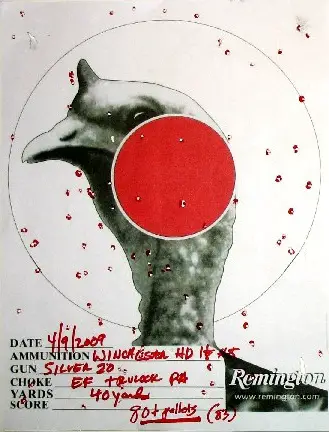
1-1/8 oz. of "really heavier than lead" Winchester 20 gauge HD #5 shot gives more pattern density than needed for a turkey at 40 yards with a Trulock PH extended choke tube.
Some might rightly ask, why 1-1/2 oz. out of a 20 gauge? Well, it certainly isn't a preferred dove load but that isn't the idea at all. It is just one shot at a turkey, not the type of shell you would consider for all-around or continuous use. The reason is self-explanatory. You don't need to drag a 12 gauge with you into the turkey hills and you can take your 20 gauge while enjoying as good or better terminal performance than many 12 gauge loads. It is just one shot and make it a good one.
The same goes for wild pheasants. The whole idea is to be ready and to the extent that a lighter, more responsive 20 gauge comes to your shoulder a bit faster and gets you on the bird a bit quicker it is an advantage, not the other way around. Certainly, there are 12 gauge nickel-plated, buffered loads that have sufficient pellet count to exceed the range of the 1-5/16 oz. Federal load I'm referring to. The patterning board shows that it isn't by much, though, perhaps five yards. A wild pheasant up in the wind doesn't take long to cover that five yards, though, and to the degree that your 20 gauge may already have him on the way down before a 12 gauge is even on the bird, the 20 gauge often wins.
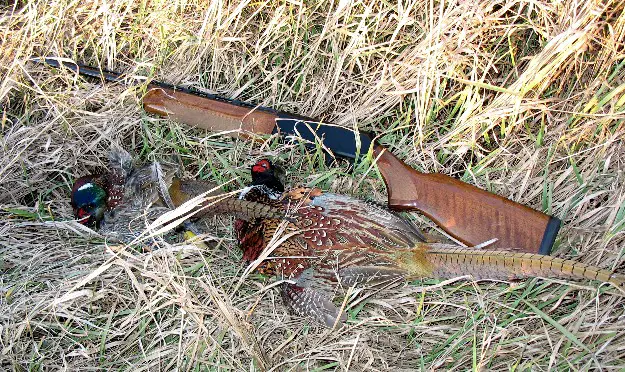
The Browning B-80 20 gauge made quick work of this pair of Illinois roosters with Fiocchi 1-1/4 oz. nickel-plated #5 "Golden Pheasant" loads and a Trulock IM Precision Hunter Extended choke tube.
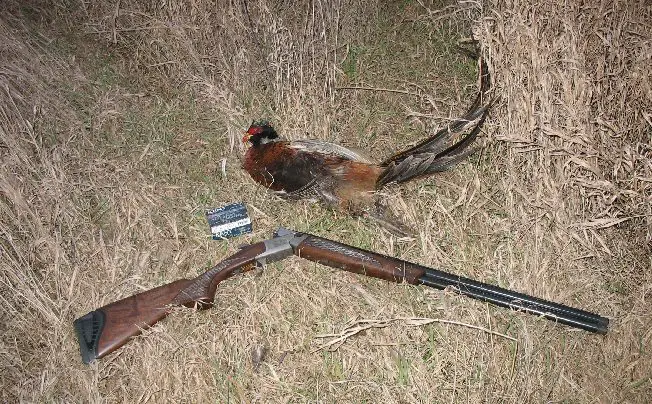
Kent Tungsten-Matrix 20 gauge 1-1/8 oz. #5 loads have no trouble getting wild pheasants dead in the air, this time out of a Cynergy O/U.
If you think that manufacturers struggle every year to make their 12 gauges sound more and more like 20 gauges, it isn't your imagination. If you try to count up all the times “Light,” “Superlight,” and “Ultralight” have been used in marketing attempts for 12 gauges you'll quickly run out of fingers and toes. These same considerations can also be made for the 16 gauge, the primary issue being that 16 gauge shotgun development and 16 gauge ammunition development have both essentially ceased. It is a great pity, but that's the reality of the situation.
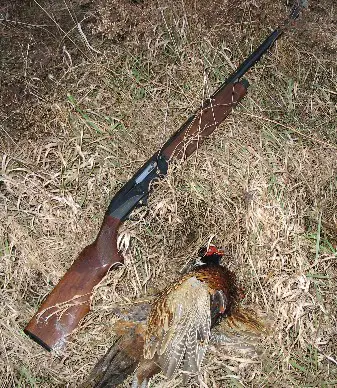
A Federal #PFC 258 1-5/16 oz. buffered #5 lead load out of this 20 gauge A303 dropped this rooster stone dead right at 50 yards. This Federal shell is the best patterning 20 gauge lead load I've ever found.
For the reloader, flyweight payloads out of the 12 gauge presents its own set of problems. Professionial ballisticians will tell you that it is difficult to develop stable, consistent loads when throwing anemic payloads out of a large diameter, mostly empty hull. This issue increases with temperature changes as well. Most people don't care all that much about powder dynamics in an overbore hull, but they do when they get bloopers in cold weather, erratic velocities, or their gun morphs into a jam-o-matic. Twenty gauge shells with 7/8 oz. payloads at moderate velocities rarely have these issues.
I'm happy to stop far short of saying a 20 gauge is the best option for all applications. There is a case capacity limit, so if heading to the goose pit is the job at hand, no question for me at all: it is a 12 gauge that gets to hunt.
The versatility and effectiveness of the 20 gauge with the right ammo and choke is sorely underestimated. Folks will make up their own minds, but for me the answer to “Wouldn't You Really Rather drive a 20 Gauge?” is an easy one. Yes, of course, and about 90% of the time that is what I drive as a result.
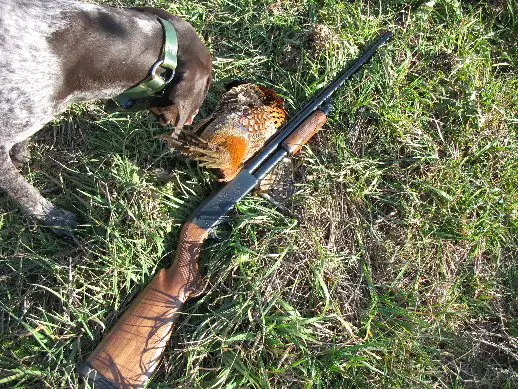
It was a Winchester 1-5/16 oz. #5 shot three inch shell (#STH2035) that did a number on this rooster out of the current production Ithaca Model 37 20 gauge. Buddy the wonderdog admires either the new Ithaca or the pheasant, I'm not sure which one.
Copyright 2010 by Randy Wakeman. All Rights Reserved.




